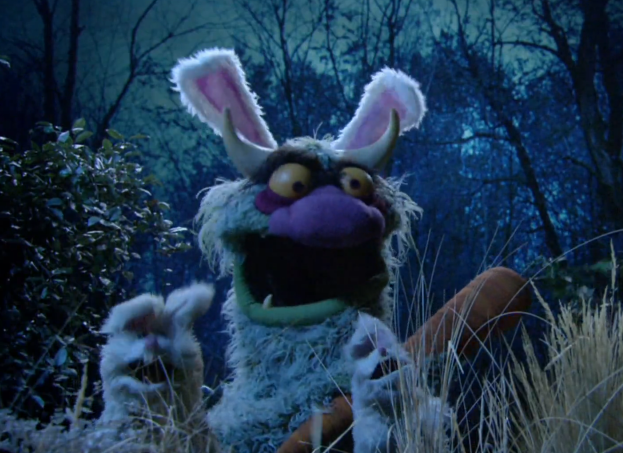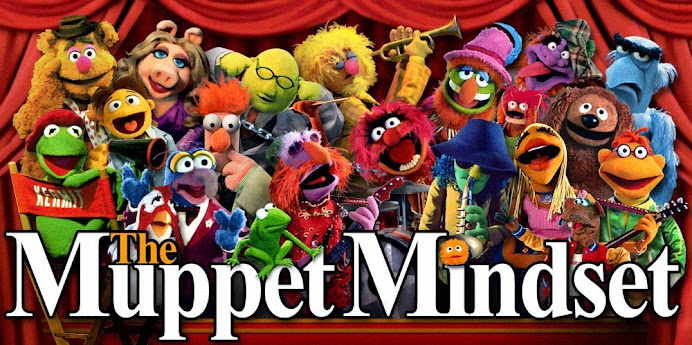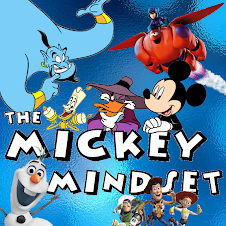Some of you will know me as Matt B. Regard or, simply, Beauregard, the anonymous Muppet fan who has had an admittedly large presence in the community for many years. Although, honestly, I’ve been very lax in terms of my involvement within the Muppet fandom community lately; I decided to return with some lessons that I have learned from the over-analysis of Lady Gaga’s art by the wonderfully talents and amazingly intellectual art people over at http://gagajournal.blogspot.com/. One of them stated: "There is no such thing as over-thinking when it comes to Gaga's art" and in my head I removed the word "Gaga" in that sentence and replaced it with "Muppets"/"Jim Henson’s"...and I had the flash of inspiration to write what is (on the surface) a parody piece about over-thinking art but which ultimately reminded me that the Muppets are often a blank canvas upon which the viewer can paint their ideas of the world around them through interpretation... which is (one of the reasons) why they became and remain so internationally and eternally successful. My love for the Muppets and all of you continues forever also. -- Beauregard
In the style of articles from Gaga Stigmata. (Over analyzing art produces art).
Carl the Big Mean (Ethical?) Egoist
Matt B. Regard - The Muppets’ message of freedom has always been ahead of its time. Before there was Lady Gaga with "Born This Way" there was Kermit with "It’s Not That Easy Being Green."
 Continuing to break boundaries in their approach to the issues that surround those watching them from the outside, the Muppets’ Big Mean Carl and his odd performance of "Stand By Me" addresses self, body image, and ultimately the all-consuming (both figurative and literal) consequences of becoming an (ethical?) egoist and one with oneself (that which is not becoming that which is--in turn defeating the original "is/not").
Continuing to break boundaries in their approach to the issues that surround those watching them from the outside, the Muppets’ Big Mean Carl and his odd performance of "Stand By Me" addresses self, body image, and ultimately the all-consuming (both figurative and literal) consequences of becoming an (ethical?) egoist and one with oneself (that which is not becoming that which is--in turn defeating the original "is/not"). Big Mean Carl (or Carl the Big Mean Whatever
Big Mean Carl (or Carl the Big Mean WhateverOur focus within this interpretation of the music video cannot focus upon Carl ‘the Bunny’ without first admitting the existence of Carl ‘the Performer’, his choreographer, costume designer and the director of the video. It is these producers, performers and artists (as well as the audience who injects and infers that which is implied and applied within the video) who allow this video to become a statement. Without the existence of performer within performance the video would instead be potentially viewed simply as obscene and we (rather than admirers) would become voyeurs of inner turmoil, violence and (admitting the existence of Carl as ‘a Bunny’) even cannibalism of one’s own kind [and allowing Carl as a ‘Bunny’, then the sating of lust and longing]. That stated [and sated]; allow exploration to begin.
 Carl ‘the Bunny’ is not a bunny. He is a monster. He is a contradiction. His statement at the start of this video "Hi, I’m a bunny!" is either the intentional lie of a bunny hunting monster or the true lie of a monster believing himself to be a rabbit (or the actual truth if literally interpreted [or a description; seeing Carl as a Playboyesque ‘Bunny’ {and don’t get me started on the Pepe-ism of Carl as a ‘bunny hunter’ in relation to the bunny hunt cited by Pepe on The Bonnie Hunt Show a few years ago}]). Carl ‘the Bunny’ of this video is not in fact a bunny and his claim to be one illustrates the awareness of Carl’s true lack of identity. He either believes himself to be the thing he claims to have become (becoming becomes being) or is baiting bunnies. Or (as can be seen through art and choreography) he is both. Hunter and hunted (bunny-hunter and bunny). The pursuit of food/bunny/tail (bunny tail) leads to his becoming that upon which he focuses/fears/hunts the most. (for reference, see Job 3:25 "That which I most feared has come upon me," or any business magazine that warns of becoming the boss you once hated, or see a food hater that eats abnormally large portions, also we all turn into our parents and that tells you something). The video and its individual contents show Carl ‘the Bunny’ become the thing he hates/hunts.
Carl ‘the Bunny’ is not a bunny. He is a monster. He is a contradiction. His statement at the start of this video "Hi, I’m a bunny!" is either the intentional lie of a bunny hunting monster or the true lie of a monster believing himself to be a rabbit (or the actual truth if literally interpreted [or a description; seeing Carl as a Playboyesque ‘Bunny’ {and don’t get me started on the Pepe-ism of Carl as a ‘bunny hunter’ in relation to the bunny hunt cited by Pepe on The Bonnie Hunt Show a few years ago}]). Carl ‘the Bunny’ of this video is not in fact a bunny and his claim to be one illustrates the awareness of Carl’s true lack of identity. He either believes himself to be the thing he claims to have become (becoming becomes being) or is baiting bunnies. Or (as can be seen through art and choreography) he is both. Hunter and hunted (bunny-hunter and bunny). The pursuit of food/bunny/tail (bunny tail) leads to his becoming that upon which he focuses/fears/hunts the most. (for reference, see Job 3:25 "That which I most feared has come upon me," or any business magazine that warns of becoming the boss you once hated, or see a food hater that eats abnormally large portions, also we all turn into our parents and that tells you something). The video and its individual contents show Carl ‘the Bunny’ become the thing he hates/hunts. One clear signal from which this message of the video can be extrapolated is the use of an ‘identifier’ which clues us in to the story being told. Artists have often used items such as their fashion wardrobe, their props or their lyrics to draw the viewer to conclusions they may not have otherwise perceived. In this case, a carrot. Certainly Carl ‘the Performer’ would be aware of the historical use of carrots within artwork and the inclusion of the carrot here (oversized, like a giant arrow pointing to Carl ‘the Bunny’ and his war waged on self) can be connected intrinsically to carrots in past artworks.
One clear signal from which this message of the video can be extrapolated is the use of an ‘identifier’ which clues us in to the story being told. Artists have often used items such as their fashion wardrobe, their props or their lyrics to draw the viewer to conclusions they may not have otherwise perceived. In this case, a carrot. Certainly Carl ‘the Performer’ would be aware of the historical use of carrots within artwork and the inclusion of the carrot here (oversized, like a giant arrow pointing to Carl ‘the Bunny’ and his war waged on self) can be connected intrinsically to carrots in past artworks. Carrots have been used in art for decades and one such reference is the use of a carrot in the art mural of the Last Supper in which the root vegetable is strategically placed upon the table to point to he that dips into the bowl with Jesus (Judas) (see right). This connection draws obvious parallels between deception (the hunter)/betrayal (of self and of others) and Carl ‘the Bunny’ of ‘Stand By Me’. Another reference using carrots in art is an oil painting by Peter Aertsen from 1559 of Christ and the Adulteress about to be stoned (the hunted) [the ‘Bunny’?]. Both these concepts are combined within the equally famous and lasting sculpture of a bunny produced from the core of a carrot. This final illustration truly mirrors the story of hunter becoming the hunted as it shows the eaten (carrot) becoming (becomes being) the eater (bunny).
Carrots have been used in art for decades and one such reference is the use of a carrot in the art mural of the Last Supper in which the root vegetable is strategically placed upon the table to point to he that dips into the bowl with Jesus (Judas) (see right). This connection draws obvious parallels between deception (the hunter)/betrayal (of self and of others) and Carl ‘the Bunny’ of ‘Stand By Me’. Another reference using carrots in art is an oil painting by Peter Aertsen from 1559 of Christ and the Adulteress about to be stoned (the hunted) [the ‘Bunny’?]. Both these concepts are combined within the equally famous and lasting sculpture of a bunny produced from the core of a carrot. This final illustration truly mirrors the story of hunter becoming the hunted as it shows the eaten (carrot) becoming (becomes being) the eater (bunny). Furthermore, Carl ‘the Bunny’’s use of the carrot as a weapon illustrates an attitude held by many towards food, that food is a weapon that fights against the wished for Western identity of thinness/super-model looks [looks of the ‘Bunny’s]. However, this video twists that thought backwards upon itself as the specific food/weapon is a carrot/vegetable, which theoretically should be the savior of the identify (through healthy eating) and thus illustrates the dark lightness that whilst unhealthy food (or food itself) may be seen as a weapon, dieting and changing oneself to match society through carrot eating is also seen as weaponry thinking. (It also links back to the myth that British soldiers leaked a story that they had become able to see in the dark due to eating copious amounts of carrots when in fact they had discovered radar. Good over evil with the use of the carrot {and lies}). [Not to mention, bunny...carrot. Make the connections that I refuse to make here on the family friendly site].Throughout the video, link becomes link becomes link (becomes Link? becomes swill?) Carrot becoming weapon; hunter becoming hunted; that which he wishes to ‘stand by him’ becomes stood IN him and singing the chorus.
Furthermore, Carl ‘the Bunny’’s use of the carrot as a weapon illustrates an attitude held by many towards food, that food is a weapon that fights against the wished for Western identity of thinness/super-model looks [looks of the ‘Bunny’s]. However, this video twists that thought backwards upon itself as the specific food/weapon is a carrot/vegetable, which theoretically should be the savior of the identify (through healthy eating) and thus illustrates the dark lightness that whilst unhealthy food (or food itself) may be seen as a weapon, dieting and changing oneself to match society through carrot eating is also seen as weaponry thinking. (It also links back to the myth that British soldiers leaked a story that they had become able to see in the dark due to eating copious amounts of carrots when in fact they had discovered radar. Good over evil with the use of the carrot {and lies}). [Not to mention, bunny...carrot. Make the connections that I refuse to make here on the family friendly site].Throughout the video, link becomes link becomes link (becomes Link? becomes swill?) Carrot becoming weapon; hunter becoming hunted; that which he wishes to ‘stand by him’ becomes stood IN him and singing the chorus. The expression ‘you are what you eat’ can be applied in spades here as Carl ‘the Bunny’ uses the food traditionally associated with rabbits (a carrot) in order to defeat and eat them only to become that which he eats (the bunnies/a bunny) and thus he becomes defeated by the food traditionally associated with Carls (bunnies) and becomes (he claims) a bunny himself...raising the question, will he now hunt/defeat/eat himself (either literally or spiritually)? Watching the video once then beginning it from the start completes the circle of the video as his claim at the beginning of "Hi, I’m a bunny" is strengthened by watching his actions throughout as becoming becomes being.
The expression ‘you are what you eat’ can be applied in spades here as Carl ‘the Bunny’ uses the food traditionally associated with rabbits (a carrot) in order to defeat and eat them only to become that which he eats (the bunnies/a bunny) and thus he becomes defeated by the food traditionally associated with Carls (bunnies) and becomes (he claims) a bunny himself...raising the question, will he now hunt/defeat/eat himself (either literally or spiritually)? Watching the video once then beginning it from the start completes the circle of the video as his claim at the beginning of "Hi, I’m a bunny" is strengthened by watching his actions throughout as becoming becomes being. Carl ‘the Bunny’ becomes the ultimate self-destroying ethical egoist (one who does only what is in their best interest to the point that in time it becomes the thing which is not in their best interest). By definition, an ethical(?) egoist may do only that which is best for them (such as drilling for oil or using non-green gasoline for their Hummers) but the self-destroying ethical egoist follows this belief so strongly that it becomes their own end (as natural resources are used up and the ozone layer is peeled away). Illustrating his self-destroying ethical egoistical ways, Carl ‘the Bunny’ hunts bunnies and in doing so becomes one with the bunnies which he hunts (/hates?/[loves?]/loves to eat?) until ultimately he could never continue this circle of destruction without hunting/hating/eating himself.
Carl ‘the Bunny’ becomes the ultimate self-destroying ethical egoist (one who does only what is in their best interest to the point that in time it becomes the thing which is not in their best interest). By definition, an ethical(?) egoist may do only that which is best for them (such as drilling for oil or using non-green gasoline for their Hummers) but the self-destroying ethical egoist follows this belief so strongly that it becomes their own end (as natural resources are used up and the ozone layer is peeled away). Illustrating his self-destroying ethical egoistical ways, Carl ‘the Bunny’ hunts bunnies and in doing so becomes one with the bunnies which he hunts (/hates?/[loves?]/loves to eat?) until ultimately he could never continue this circle of destruction without hunting/hating/eating himself.Thus Carl ‘the Bunny’ becomes an enigma; an idea too big to exist... or an artistic expression left open for the interpretation of those whose over analysis causes art to become Art.
NOTE FROM RYAN: I think I blacked out there for a minute... What the heck just happened?
The Muppet Mindset by Ryan Dosier


















I am bunny too. Hop Hop!
ReplyDeleteThis is the only muppet skit I absolutely hated.
ReplyDelete